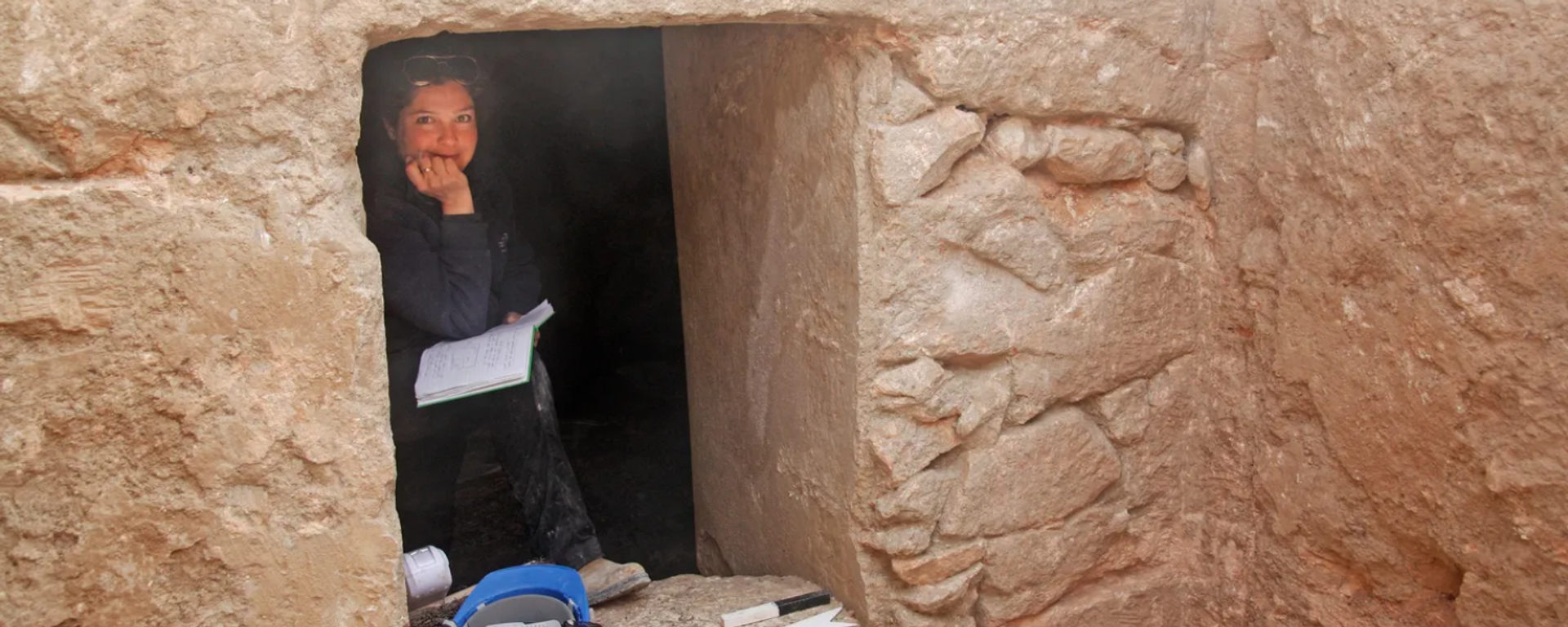https://sputnikglobe.com/20230927/long-lost-artemisia-gentileschi-painting-rediscovered-over-100-years-later-1113750852.html
Long-Lost Artemisia Gentileschi Painting Rediscovered Over 100 Years Later
Long-Lost Artemisia Gentileschi Painting Rediscovered Over 100 Years Later
Sputnik International
The painting dates from the late 1630s, and is just one of several compositions the young painter made of the subject. It was created by the Italian Baroque artist Artemisia Gentileschi, a significant female artist.
2023-09-27T22:33+0000
2023-09-27T22:33+0000
2023-09-27T22:30+0000
beyond politics
art
history
italy
england
https://cdn1.img.sputnikglobe.com/img/07e7/09/1b/1113750986_0:160:3072:1888_1920x0_80_0_0_494b801813945bda05af1c494902346b.jpg
A painting that has been hiding in storage for more than 100 years has been rediscovered and brought back to life, officials have revealed. The painting was created by the Italian Baroque artist Artemisia Gentileschi, the daughter of artist Orazio Gentileschi who was a follower of Michelangelo Merisi da Caravaggio. The painting dates from the late 1630s, and is just one of several compositions the young painter made of the subject.The painting is based on the biblical tale of "Susanna and the Elders," a story in chapter 13 of the Book of Daniel in which two elderly men spied on a bathing women named Susanna and then demanded sexual favors from her. The pair threatened to accuse her of adultery should she refuse, but their plan failed. Anna Reynolds, the deputy surveyor of The King’s Pictures, says that within the painting viewers are able to see the discomfort felt by Susanna as the two men leer at her while she bathes."We are so excited to announce the rediscovery of this important work by Artemisia Gentileschi," said Reynolds when the Royal Collection Trust unveiled the restored painting at Windsor Castle.The painting is being reattributed to Artemisa, after it was misinterpreted as being made by a French artist and was stored for more than 100 years at Hampton Court Palace. It is now being put on public display at Windsor Castle. The letters CR—for Carolus Rex—were also found branded on the back of the canvas, as proof that it was a part of King Charles I’s collection.Using x-radiography analysis and infrared reflectography, conservationists were able to see Artemisia’s work process, including elements she had altered in the painting. The nearly 400-year-old painting’s original details and colors, which were smothered by thick varnish, were also restored and repaired.Other well known works by Artemisia include "Judith Slaying Holofernes" and "Judith and Her Maidservant," with much of her work focusing on women from myths, allegories and biblical stories. Her professional career, which began when she was 15-years-old, has often been overshadowed by the story of her being raped by her father’s friend Agostino Tassi in 1611, when she was 18.Over the course of a seven-month trial, other crimes against Tassi were discovered, such as Tassi having planned to steal Orazio’s paintings, and possibly raping or committing adultery with his sister-in-law, as well as murdering his wife. Artemisia was tortured to give evidence during the trial in order to ensure that her accusation of rape was not false. Tassi was sentenced to be exiled from Rome, but the sentence was not carried out. In 1616, Artemisia became the first woman to join Florence’s Academy of Drawing, and despite what was seen as a damaged reputation for its time following the rape trial, she married one month after the trial before moving to Florence, where she became a court painter under the patronage of the House of Medici. By 1638, Artemisia had King Charles I personally invite her to London to work for him, where she painted her most original and important work.Her collection of work is thought to be self-evidently autobiographical - a rare feat for Renaissance and baroque female artists.The piece hung at Whitehall Palace in the “Queen’s Withdrawing Chamber” according to a 1639 royal inventory before being moved to storage at Hampton Court Palace. "It was very much the Queen's painting."
https://sputnikglobe.com/20230927/with-leaning-tower-of-pisa-type-of-experiment-physicists-find-antimatter-affected-by-gravity-too-1113748568.html
https://sputnikglobe.com/20230927/israeli-archaeologists-find-possible-first-known-grave-of-ancient-greek-courtesan-1113749681.html
italy
england
Sputnik International
feedback@sputniknews.com
+74956456601
MIA „Rosiya Segodnya“
2023
Mary Manley
https://cdn1.img.sputnikglobe.com/img/07e6/01/0b/1092187887_0:0:2048:2049_100x100_80_0_0_0c2cc4c84f89aff034cc55bb01fb6697.jpg
Mary Manley
https://cdn1.img.sputnikglobe.com/img/07e6/01/0b/1092187887_0:0:2048:2049_100x100_80_0_0_0c2cc4c84f89aff034cc55bb01fb6697.jpg
News
en_EN
Sputnik International
feedback@sputniknews.com
+74956456601
MIA „Rosiya Segodnya“
Sputnik International
feedback@sputniknews.com
+74956456601
MIA „Rosiya Segodnya“
Mary Manley
https://cdn1.img.sputnikglobe.com/img/07e6/01/0b/1092187887_0:0:2048:2049_100x100_80_0_0_0c2cc4c84f89aff034cc55bb01fb6697.jpg
art, art history, rome, italy, italian art, baroque art, england, artemisia gentileschi
art, art history, rome, italy, italian art, baroque art, england, artemisia gentileschi
Long-Lost Artemisia Gentileschi Painting Rediscovered Over 100 Years Later
The once-lost painting was unearthed in an inventory of art owned by King Charles I - the king of England, Scotland, and Ireland from March 1625 until his execution in 1649.
A
painting that has been hiding in storage for more than 100 years has been rediscovered and brought back to life, officials have revealed.
The painting was created by the Italian Baroque artist Artemisia Gentileschi, the daughter of artist Orazio Gentileschi who was a follower of Michelangelo Merisi da Caravaggio. The painting dates from the late 1630s, and is just one of several compositions the young painter made of the subject.
The painting is based on the biblical tale of "Susanna and the Elders," a story in chapter 13 of the Book of Daniel in which two elderly men spied on a bathing women named Susanna and then demanded sexual favors from her. The pair threatened to accuse her of adultery should she refuse, but their plan
failed.
Anna Reynolds, the deputy surveyor of The King’s Pictures, says that within the painting viewers are able to see the discomfort felt by Susanna as the two men leer at her while she bathes.
"We are so excited to announce the rediscovery of this important work by Artemisia Gentileschi," said Reynolds when the Royal Collection Trust unveiled the restored painting at Windsor Castle. "Artemisia was a strong, dynamic and exceptionally talented artist whose female subjects — including Susanna — look at you from their canvases with the same determination to make their voices heard that Artemisia showed in the male-dominated art world of the 17th century."

27 September 2023, 20:11 GMT
The painting is being reattributed to Artemisa, after it was misinterpreted as being made by a French artist and was stored for more than 100 years at Hampton Court Palace. It is now being put on public display at Windsor Castle. The letters CR—for Carolus Rex—were also found branded on the back of the canvas, as proof that it was a part of King Charles I’s collection.
Using x-radiography analysis and infrared reflectography, conservationists were able to see Artemisia’s work process, including elements she had altered in the painting. The nearly 400-year-old painting’s original details and colors, which were smothered by thick varnish, were also restored and repaired.
"When it came into the studio, Susanna was the most heavily overpainted canvas I had ever seen, its surface almost completely obscured," conservator Adelaide Izat said. "It has been incredible to be involved in returning the painting to its rightful place in the Royal Collection, allowing viewers to appreciate Artemisia's artistry again for the first time in centuries."
Other well known works by Artemisia include "Judith Slaying Holofernes" and "Judith and Her Maidservant," with much of her work focusing on women from myths, allegories and biblical stories. Her professional career, which began when she was 15-years-old, has often been overshadowed by the story of her being raped by her father’s friend Agostino Tassi in 1611, when she was 18.

27 September 2023, 21:30 GMT
Over the course of a seven-month trial, other crimes against Tassi were discovered, such as Tassi having planned to steal Orazio’s paintings, and possibly raping or committing adultery with his sister-in-law, as well as murdering his wife. Artemisia was tortured to give evidence during the trial in order to ensure that her accusation of rape was not false. Tassi was sentenced to be exiled from Rome, but the sentence was not carried out.
In
1616, Artemisia became the first woman to join Florence’s Academy of Drawing, and despite what was seen as a damaged reputation for its time following the rape trial, she married one month after the trial before moving to Florence, where she became a court painter under the patronage of the House of Medici. By 1638, Artemisia had King Charles I personally invite her to London to work for him, where she painted her most original and important work.
Her collection of work is thought to be self-evidently autobiographical - a rare feat for Renaissance and baroque female artists.
"One of the most exciting parts of this painting's story is that it appears to have been commissioned by Queen Henrietta Maria while her apartments were being redecorated for a royal birth," art historian Niko Munz said of the rediscovered painting.
The piece hung at Whitehall Palace in the “Queen’s Withdrawing Chamber” according to a 1639 royal inventory before being moved to storage at Hampton Court Palace. "It was very much the Queen's painting."







